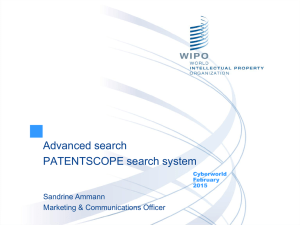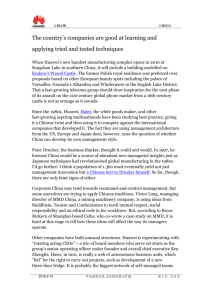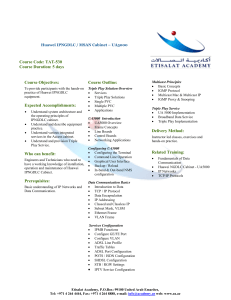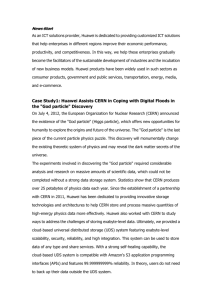Network Aware Application Mobility (NAAM) Charter Goals Data C
advertisement
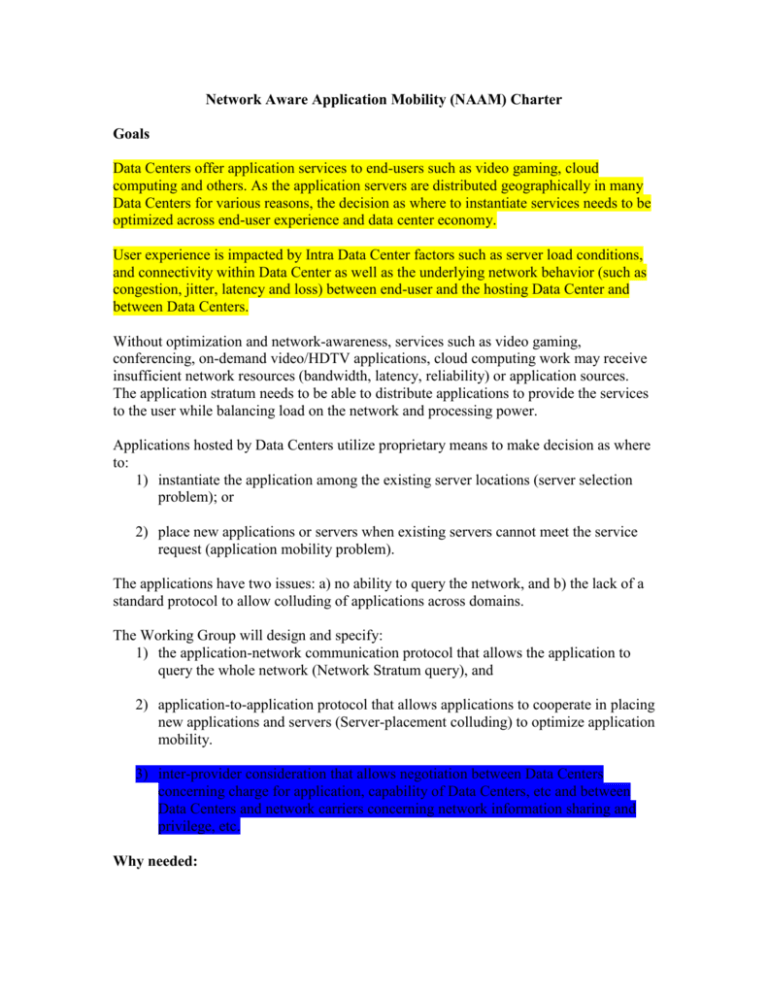
Network Aware Application Mobility (NAAM) Charter Goals Data Centers offer application services to end-users such as video gaming, cloud computing and others. As the application servers are distributed geographically in many Data Centers for various reasons, the decision as where to instantiate services needs to be optimized across end-user experience and data center economy. User experience is impacted by Intra Data Center factors such as server load conditions, and connectivity within Data Center as well as the underlying network behavior (such as congestion, jitter, latency and loss) between end-user and the hosting Data Center and between Data Centers. Without optimization and network-awareness, services such as video gaming, conferencing, on-demand video/HDTV applications, cloud computing work may receive insufficient network resources (bandwidth, latency, reliability) or application sources. The application stratum needs to be able to distribute applications to provide the services to the user while balancing load on the network and processing power. Applications hosted by Data Centers utilize proprietary means to make decision as where to: 1) instantiate the application among the existing server locations (server selection problem); or 2) place new applications or servers when existing servers cannot meet the service request (application mobility problem). The applications have two issues: a) no ability to query the network, and b) the lack of a standard protocol to allow colluding of applications across domains. The Working Group will design and specify: 1) the application-network communication protocol that allows the application to query the whole network (Network Stratum query), and 2) application-to-application protocol that allows applications to cooperate in placing new applications and servers (Server-placement colluding) to optimize application mobility. 3) inter-provider consideration that allows negotiation between Data Centers concerning charge for application, capability of Data Centers, etc and between Data Centers and network carriers concerning network information sharing and privilege, etc. Why needed: Due to the lack of cross stratum interaction between the application stratum and the underlying network stratum during application service provisioning, application services may make poor use of network resources or not achieve their overall quality of service objectives and/or being denied of service provisioning pre-maturely. This working group will focus on the Data Center applications (first). A second topic will be Data Center Video to mobile nodes (after re-chartering). Application Stratum Needs The application CSO gateway (A-CSG) in the application stratum needs to collect application level usage/performance data such as: (i) Max number simultaneous instances of the application usage or some other measure of the application; (ii) Storage assignable (e.g., max); (iii) Physical or Virtual assignment of processing, memory; (iv) Storage access rate (disk, RAM, etc.), etc. Whether virtual machine instances can be created in a different location and the mechanics of moving virtual machines are of the need of the application stratum. Whether an application must execute in multiple physical locations to provide diversity and nearly instantaneous failover is another need of the application stratum. The Working group will design and specify the application-to-application communication interface/protocol and mechanisms that will enable to collect the application-level data mentioned above. In making decisions as where to instantiate the application among the existing server locations or where to place new applications or servers when existing servers cannot meet the service request, the ability to query the network is a critical to make the application placement work effectively. The network query verifies if application instantiation works or not. The Working Group will design and specify the Application-Network communication protocol and mechanisms that will enable coordinated query of application and network requirements to available computing and network resources to determine the constraining factor. Objectives The Working Group will focus on the following items: - A “problem statement” document that provides the description of problems and key terminology. - An “architecture” document that provides the description of architecture components and their functions. This document also provides how the network query from application interacts with network processes to provide the data requested data. - A “survey” document that lists all existing works in this area - A “requirement” document that specifies requirements for the NAAM functionalities between Application Stratum and Network Stratum, identifying types of messages and information CSO interface may need for NAAM function. - A NAAM “protocol” document that defines request/reply format and semantics to allow identified functionalities on the CSO interface based on the “requirement” document. - A “protocol” document that defines interfaces between network layer controller and internet NM and policy control (PEP/PC) - A “protocol” document that defines interfaces between network layer controller and path computation element (PCE) for multi-domain path computation - An “implementation” experience document that describes CSO implementation experience or network trial. Proposed Schedule for IETF Working Group Problem statement Architecture statement Survey Document Requirements Document AS-NS Protocol NS-NM & PCP/PEP Protocol NS-PCE Implementation Report [March 2011] [March 2011] [March 2011] [July 2011] [July 2011] [July 2011] [July 2011] [November 2011] Interested Parties: Vendors: - Huawei, Ericsson, Cisco, ETRI, Iridescent Carriers: - Telefonica, Verizon, NTT, KDDI, BT, DT, China Mobile People (Attendees for Bar BOF) – 40 signed attendees Young Lee Dave McDysan Katsushi Kobayashi Xiangsong Cui Dirk Hugo Greg Bernstein Matthias Kaschub Aki Myrhinen Heeyoung Jung Dan Li Xie Lei Hideki Sunahara Daniele Ceccarelli Dave Croker Myung Ki Shin Dapeng Lin Tae Yeon Kim Oscar Gonzales de Dios Fatai Zhang Mirja Kuhlewind Quintin Zhao Duan Shihui Attila Takacs Sandoche Balakrichenan Tomonori Takeda Malcolm Betts Jonathan Saddler Yuji Tochio Tian Linyi Alvaro retana Iguas Bagdonas Guoying Zhang Xu Yunbin Antti Makela Riccardo Bernadini Kathy McEwen Bob Briscoe yajuan Wu Yosifumi Atarashi Ray Atarashi ylee@huawei.com dave.mcdysan@varizon.com ikib@AI.AIST.GO.JP Xiangsong.cui@huawei.com dirk.vou-hugo@telecom.de gregb@grotto-networking.com kaschub@ikr.uni-stuttgart.de anyrhine!@cs.helsinki.fi hyjung@etri.re.kr danli@huawei.com xielei57471@huawei.com suna@wide.ad.jp daniele.ceccarelli@ericsson.com dhc@dcrocker.net mkshin@etri.re.kr lindapeng@chinamobile.com tykim@etri.re.kr Huawei Verizon AIST Huawei DT Grotto Univ. Stuttgart ogondio@tid.cs zhangfatai@huawei.com mirja.kuehlewind@ikr.uni-shuttgart.de qzhao@huawei.com duanshihui@mail.ritt.com.cn attila.takacs@ericsson.com Telefonica Huawei Univ. Stuttgart Huawei sandoche.balakrichenan@afnic.fr takeda.tomonori@lab.ntt.co.jp malcolm.betts@zte.com.cn saddler@homesys.org tochio@jp.fujitsu.com tianlinyi@huawei.com aretana@cisco.com bagdona@cisco.com zhangguoying@mail.ritt.com.cn xuyunbin@catr.ca antti.makela@tlek.fi riccardo.bernardini@unind.it k.mccwen@verizon.net bob.briscoe@bt.com wujajuan@huawei.com ETRI Huawei Huawei Ericsson ETRI China Mobil ETRI Ericsson NTT ZTE Tellabs Fujitsu Huawei Cisco Cisco Iridescent BT Huawei Alaxala IIJ Schedule for creation of material for IETF BOF’s consideration: Preliminary Problem statement Preliminary Architecture statement Preliminary Survey Document Preliminary Requirements Document Preliminary AS-NS Protocol Preliminary NS-NM & PCP/PEP Protocol Preliminary NS-PCE Preliminary Implementation Report [September 2010 ] [September 2010 ] [September 2010 ] [October 2010] [October 2010] [October 2010] [October 2010] [November 2011] Initial BOF work schedule Interim Meetings – 3 Meetings (September– October) Potential collaboration: NG Virtual networks, Internet 2, ITRI.



